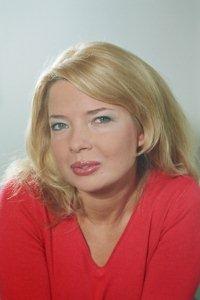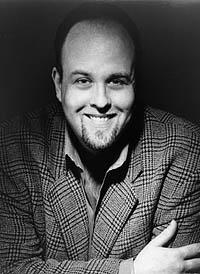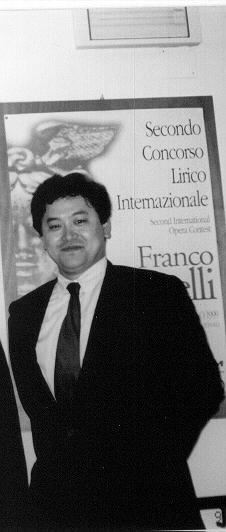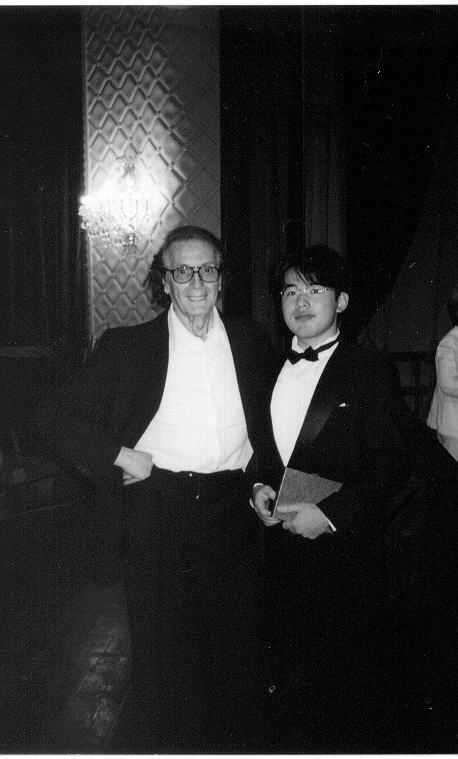|
Performance reviews: La traviata (2004), Omaggio a Franco Corelli concert (2004), Cavalleria rusticana & Pagliacci (2004), Don Carlo (2001), Eight tenors in Tokyo (1999), Recital of tenor Hyun Lee (1999), Madama Butterfly (1998), Nabucco (1998)
The banquet at the beginning of the opera was set in a quite somber atmosphere instead of being cheerful as depicted by the music. The sets were moving in and out of position to transport the action in different places of the house. This was an interesting effect and did not deter from the plot. The same thing happened during the party at Flora's house. Somber atmosphere to start with and moving sets to relocate the action into different rooms. The production by Ronconi, sets by Margherita Palli and costumes by Carlo Maria Diappi were fortunately traditional and set in the 1850s as it should be. Here no tedious relocation to modern time as was done recently in Venezia.
The concert was planed by Akira "Franco" Sakai, a great admirer of the late tenor. The program contained messages from Alessandro Sciochetti, Associazione Amici della Lirica Franco Corelli Ancona and Fabio Sturani, mayor of Ancona. By the way, I cannot remember a concert in the US organized in the memory of Franco Corelli. The Met is such a depressing place. It was interesting to attend the complete rehearsal before the concert and witness the problems the singers faced and the way everything was solved for the concert. We had three tenors, with two sopranos, one mezzo-soprano and one baritone for duets with the tenors. Each tenor sang four pieces and one encore. For me there was a new Japanese tenor Suguru Yonezawa, who just issued a new CD with arias from Tosca, Turandot, Manon Lescaut, Aida, La bohème, Il trovatore, Rigoletto, Carmen, Faust, Andrea Chénier, and Neapolitan songs. Yonezawa sang Celeste Aida, La fatal pietra with Junko Kawamura, La fleur que tu m'avais jetée, Un dì all'azzuro spazio and Catarì. Yonezawa hit the high B flat in Celeste Aida, something that did not happen at the Met Aida performance I heard recently. Yonezawa provided strong singing, good top notes and sensitivity where needed. The Carmen aria was sung in excellent French. Junko Kawamura was good as Aida in the death scene. The mezzo-soprano Rika Itanami appeared briefly during the duo to sing the final phrases sung by Amneris at the closing of Aida. The Italian Maurizio Saltarin was just a name for me until today. He was replacing the announced Ernesto Grisales. Saltarin sang Già nella notte densa with Yukiko Yamashita, Amor ti vieta, Recondita armonia, Tu qui, Santuzza with Rika Itanami and Musica proibita. Saltarin is the possessor of a strong, powerful voice with a good top. The Otello duet was sung with the necessary reflective mood by Saltarin and Yamashita. The Amor ti vieta was strong and properly verist. Having heard recently Cavalleria rusticana both in Tokyo and New York, the duet Tu qui, Santuzza with Saltarin and Itanami was compelling both vocally and theatrically. One has to wonder why Itanami was not singing Santuzza recently in Tokyo. The Musica proibita that I only knew only from records was a welcome first. The last tenor, Nicola Martinucci, has been singing for many years, and he is ignored by places such as the Met, probably a not sensitive enough tenor for the current incompetents that manage the current opera world. Martinucci sang Nessun dorma, La vita è inferno all'infelice, Invano, Alvaro with Akiro Nishida, Niun mi tema and 'O sole mio. Martinucci was in tremendous voice. His rendering of Nessun dorma was stunning, while he mastered the difficult Forza aria. The Forza duet was very exiting, and he finished with a powerful death of Otello. Nishida, a young baritone, has a good voice that needs maturing. He was a bit overwhelmed by Martinucci. One can only hope that Martinucci has many more years to sing like that. Gianni Kriscak was the evening's pianist and provided excellent accompaniment. The concert had a tremendous success. One last word on the acoustics of the hall, it was outstanding with a wooden floor. One can only wonder why the Met, HGO and the San Francisco War Memorial Opera House still have heavy carpeting. It looks good and kills the acoustics. Before the start of the second part of the concert, E lucevan le stelle sung by Corelli in 1967 at Parma was played to the audience as a memorial to a voice not to be heard live again. We must also remember that part of the success of that 1967 Tosca was due to the participation of the conductor, maestro Morelli. If Muti would have been present at Parma that night, the whole thing would have been very different.
The curtain opened during the prelude of Cavalleria rusticana showing the village's center with the church on the right and the house of Alfio being also located on the town center square, with Turiddu and Lola appearing in full view on the balcony. Certainly a mistake, if one considers the libretto: Turiddu did not sing the siciliana backstage. The costumes of the Sicilians did not look very Sicilian either. The sets for Pagliacci are located in the same village as it looks like. I have seen before a similar production at the ENO where both stories were connected on successive days. Otherwise there was no modern craziness in the production by Grischa Asagaroff. Regarding the singing, we had a below average Cavalleria rusticana with:
Attila Kiss as Turiddu, a role he should not sing, and his Italian needs to be improved. This Don Carlo was given in a mix Italian/Japanese cast. The original production, scenery and costume design was by Luchino Visconti. Something I am not accustomed to see anymore, is that the set looks to be of the period of the piece, instead of a screwball invention by a new producer. The only thing I can object to is that when Filippo enters and sings Perché sola è la regina? Non una dama almeno presso di voi serbaste?, the Countess d'Arenberg is already present. On the singer side, we have a mixed bag. The Carlo, Shigehiro Sano, is a lirico, so his voice is not suited for the role. Sano had some minor vocal incidents due to the pressure put on his organ. He was at his best during the last act duet with Elisabetta. Sano enjoyed a great success, because of the home crowd decision, not on vocal merits. Renato Bruson sang Rodrigo. Due to his advanced age, I was expecting the worse. I was wrong. Bruson is an intellectual singer and managed a well rounded portrait. Bruson kept his voice under control most of the time. Only in some sustained phrases did his voice show a wobble. He was firmly audible. Roberto Scandiuzzi as Filipo was at the end a disappointment. He is the possessor of a good voice and he was very impressive during act 1. But during the autodafé, Scandiuzzi seemed to be mute and reserving himself for his forthcoming aria and duo. But he did not make much of his aria, quite bland, and the duo with a baritone Inquisitore (Yuichi Toyoshima) went for nothing. As Eboli, Mihoko Fujimura displayed a powerful voice suited for O don fatale. The Elisabetta of Fiorenza Cedolins was excellent, displaying exquisite pianissimo, making much of Tu che le vanità and being very effective at the final O ciel!. On the comprimario side, we had positive contributions by Masumi Kubota (Frate), Noriko Ieda (Tebaldo), Satoshi Chubachi (Lerma), and Mieko Sato (Voce dal cielo), while Kazuhiko Ichikawa as Araldo was comical. Daniele Callegari kept the affair moving well.
This was the third event organized by Akira "Franco" Sakai centered on the tenor voice.
On January 17th 1998, he organized the first concert with three tenors, while the second event took place on November 28th 1998. This year, it was an event with eight tenors. The Toho Seimei Hall sits 340 people and has reasonable acoustics. The program was divided in three parts, each with a piece by each tenor. In alphabetical orders the tenors were:
The chosen tenors ranged in age from their early twenties up to their sixties. The program of the concert, arranged here by tenor and in the order they sang the pieces during the evening, consisted of: Tetsuya Arime
Osamu Higashiono
Seiya Munakata
Toshiaki Murakami
Yasuharu Nakajima
Reiji Yabe
Ittetsu Yamauchi
The concert was opened by Yasuharu Nakajima singing Marechiare It was followed by five other Italian songs sung by Murakami, Higashiono, Munakata, Arime and Yamauchi. All the tenors were pleasant in their different tasks. Things got more serious towards the end of the first part. Reiji Yabe sang A te, o cara. It was very well done in spite of him suffering from a cold. Only on the C sharp, Mr. Yabe had problems sustaining the high note. The pitch could not be maintained. It was a pity as Mr. Yabe can easily reach a high D. The first part was concluded by Yasuhiro Okamoto singing Amici miei. He had some problems with one of the high Cs.
The highlights of the second part were:
In the third part I was looking forward to the aria Parmi veder le lagrime ... Possente amor. However Reiji Yabe, suffering from his
cold, decided not to go for a high D. A real pity, but understandable. I was waiting also for Quando le sere sung by Toshiaki
Murakami. He was excellent until the end when something got into his throat and he could not clear it for the final note, which was not as
good as one could have expected. Five other tenors sang Vesti la giubba; Cielo e mar; O tu che in seno; Tombe degli
avi miei; Che gelida manina. All were pleasant. However the hit of the third part and evening was Nessun dorma, sung
magnificently by Yasuharu Nakajima with a brilliant sustained final note.
There were two encores at the end of this very good afternoon of tenor singing: Torna a Surriento and 'O sole mio, sung
brilliantly by all the tenors together.
Franco Sakai must be complimented for organizing such events. We hope that it is followed next year by at least one more concert with many
tenors.
I went especially to Tokyo for next day's concert with eight tenors! Having some free time that evening thanks to the Northwest Orient flight
being unusually, at least for me, on time, I decided to hear Korean tenor Hyun Lee's recital at the Kioi hall located close to New Otani
Hotel. Kioi Hall is a modern hall sitting 800 people and having an excellent acoustics. I attended the recital with the organizer of the
eight tenors concert, Franco Sakai. The Italian tenor Gianfranco Pastine, currently teaching in Japan, was also present. According to the
program notes, Hyun Lee graduated from the Rossini conservatory, won the 1992 Gigli and 1993 Lauri-Volpi competitions and made his debut in
1993 as Werther in Italy. The program was divided in two parts. The first part was a conventional recital made up of: a lied (Schubert:
Aufenthalt), songs (Non t'amo più and L'ultima canzone, by Tosti) and arias (Lucia di Lammermoor Tombe degl'avi miei, Luisa
Miller Quando le sere, Carmen La fleur que tu m'avais jetée and L'Arlesiana Lamento di Federico. The purpose of
the lied was to warm up the tenor. It was pleasant, but the piece is quite boring. By the end of the first part, Lee had gained the
full measure of his voice. Up to that point, Lee displayed a nice voice with some intonation problems and some sounds that were too open.
Nervous, he sang the second verse of the Luisa Miller aria twice.
The program of the second part was quite unusual. It was made of a concert style version, sung in Japanese, of Das Land des
Lächelns. The cast was reduced to two persons, Sou-Chong and Lisa. Some minimal sets were used. As Sou-Chong, Lee was very much at
ease and sang freely and with conviction. His partner as Lisa was the soprano Noriko Sasaki. She has a nice voice with a thin and limited
top. At the end, Lee gave two encores: a fisherman barcarole in Korean, which was very lively and well sung, and Core 'ngrato that concluded
the evening successfully.
The New National Theater is a newly opened opera house. It is beautifully done, has excellent acoustics and sits approximately 1800 people.
The new production of Madama Butterfly is reported not to have had much money available, because of the money spent for the production of Aida
with Cura. However while the sets do not look expensive, they serve the story well and the overall production does not try to improve the
opera, which is a blessing. The best overall performance was by Yasuko Hayashi as Butterfly. Even at this stage of her career, Hayashi still
interprets the role convincingly and sings strongly. The Suzuki of Aiko Kori made a positive impression in spite of an average voice, while
the Goro of Ken Matsuura was the best of the men, both in voice and acting. Alfredo Portilla was a Pinkerton without much voice, brilliance
at the top or stamina. However, he was better than Vladimir Grishkov that I heard in the same role in Houston during February. David A.
Okerlund, as Sharpless, was nondescript. The conducting of Yoshinori Kikuchi kept things moving smoothly, but without much dramatic impetus.
After having visited Tokyo for 18 years, I finally managed to attend an operatic performance. Nabucco was given a semi-staged performance.
Suntory Hall sits about 1800 people and has excellent acoustics, which is a change from what I am accustomed to in Houston, a large hall with
bad acoustics. The producer, Omri Nitzan, had the not-so-new idea of telling the story of the Jews in Assyria as if it was happening during
the holocaust. However there was no swastika, but a clinched fist depicted the oppressor of the Israelis. When the Assyrians gods are
shattered in the last act, an exploding clinched fist was shown on a screen. Screen projections were used to depict the different scenes of
the opera. The costumes were a mixture of ancient and modern, never a good mixture, as this makes no sense at all. Abigaille looked like a
dominatrix with a long slit in her dress, exposing the good-looking legs of Guleghina. The Japanese have also succumbed to the surtitles craze.
However here, they are naturally in Japanese, which does not disturb me, and the local audience does not laugh at the most stupid moments as
it is customary in the US. The singing was on a high level. The best overall portrayal was the Zaccaria of Ferruccio Furlanetto, dignified
in the prayer and bringing the house down with his singing in the scene following the well known chorus. The Abigaille of Maria Guleghina was
also stunning in the first part of the evening. Guleghina displayed a tremendous upper register, and fearlessly attacked high notes. After
the intermission, she tired a little bit, but her death was moving. I sincerely hope that she will not damage her voice like Suliotis and
Callas. Suliotis was very exciting like Guleghina, while Callas did not have the basic raw vocal material of Guleghina. Renato Bruson, as
Nabucco, showed that he had plenty left, even after such a long career. Bruson never had a thundering voice, but his qualities are still
present, smooth singing, importance given to the words, and emotion-filled singing. It was a pleasure to hear him again, after an
interruption of ten years. Adding to the positive impression was Elena Zaremba as Fenena, unfortunately a very small role. The only deficit
was the filiform tenor Fabio Armiliato. He always looks quite funny, but does not impress with his voice. Why he is singing principal roles
all over the world is a mystery. Fortunately Ismaele is quite an insignificant role. The talented operatic conductor Daniel Oren conducted
the performance. Mr. Oren supports the singer well and he does not mind stopping the action to have the singers applauded after a well-sung
aria or ensemble. He even insists for curtain calls after each act, a refreshing change to what I am accustomed to in Houston.
|
 Having heard Shigehiro Sano here as Don Carlo completely miscast in this role, I was curious to hear him in a role better suited to his voice.
He has a voice with the proper power to fill the house in such a role. However during act 1, there was a slight wobble creeping in from time
to time. This is not a good sign for the future. During act 2, scene 1 the same thing happened during Lunge da lei ... Dei miei bollenti
spiriti. However the voice was already in better shape. His delivery of the aria was matter of fact. He did not try to spin the line
Dei miei bollenti spiriti à la Valetti. The cabaletta was not cut, and Sano did not interpolate what is expected from any tenor
singing it. No high note means, the cabaletta ends in a letdown. Sano is not a high C tenor, or B for that matter. However by the party's
at Flora, his voice was under control and he delivered a powerful Scena della borsa. In act 3, he sang with confidence, power and a nice line
Parigi, o cara and was dramatically fine in the death scene.
Having heard Shigehiro Sano here as Don Carlo completely miscast in this role, I was curious to hear him in a role better suited to his voice.
He has a voice with the proper power to fill the house in such a role. However during act 1, there was a slight wobble creeping in from time
to time. This is not a good sign for the future. During act 2, scene 1 the same thing happened during Lunge da lei ... Dei miei bollenti
spiriti. However the voice was already in better shape. His delivery of the aria was matter of fact. He did not try to spin the line
Dei miei bollenti spiriti à la Valetti. The cabaletta was not cut, and Sano did not interpolate what is expected from any tenor
singing it. No high note means, the cabaletta ends in a letdown. Sano is not a high C tenor, or B for that matter. However by the party's
at Flora, his voice was under control and he delivered a powerful Scena della borsa. In act 3, he sang with confidence, power and a nice line
Parigi, o cara and was dramatically fine in the death scene.  The Violetta was Marina Vyskvorkina. She sings right now in Prague, Hamburg, Berlin, Karlsruhe, Boston and Ludwigsburg and has a
The Violetta was Marina Vyskvorkina. She sings right now in Prague, Hamburg, Berlin, Karlsruhe, Boston and Ludwigsburg and has a  Germont was Christopher Robertson. He displayed a voice of medium size, well used and projected for that house. I remembered him as a very
discreet Sharpless a few years back in Houston. The lack of proper acoustics in Houston was probably the cause of it. The body of
Robertson's voice needs good acoustics to be heard. Both singers went through the gamut of all the emotions depicted in Verdi's music. Di
provenza il mar, il suol was well delivered with the necessary poignancy. During the final of act 2, Vyskvorkina was
appropriately poignant. During the ultimate act, Vyskvorkina was outstanding in Addio del passato, Gran Dio, morir si giovane
and the ensuing duet with Alfredo. She died with great emotion and vocal power. None of the comprimari detracted from the excellence of the
performance. The whole thing was well conducted by the veteran Hiroshi Wakusagi, who conducted opera for many years in Germany and was at one
time the music director of the Tonhalle orchestra in Zürich.
Germont was Christopher Robertson. He displayed a voice of medium size, well used and projected for that house. I remembered him as a very
discreet Sharpless a few years back in Houston. The lack of proper acoustics in Houston was probably the cause of it. The body of
Robertson's voice needs good acoustics to be heard. Both singers went through the gamut of all the emotions depicted in Verdi's music. Di
provenza il mar, il suol was well delivered with the necessary poignancy. During the final of act 2, Vyskvorkina was
appropriately poignant. During the ultimate act, Vyskvorkina was outstanding in Addio del passato, Gran Dio, morir si giovane
and the ensuing duet with Alfredo. She died with great emotion and vocal power. None of the comprimari detracted from the excellence of the
performance. The whole thing was well conducted by the veteran Hiroshi Wakusagi, who conducted opera for many years in Germany and was at one
time the music director of the Tonhalle orchestra in Zürich.

